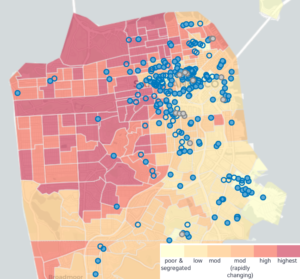Thank you to Gustavo Velasquez (“GV”), HCD Director, and Tyrone Buckley (“TB”), Assistant Deputy Director of Fair Housing, for sharing their time with us for this conversation on the crucial topic of affirmatively furthering fair housing (AFFH) — the legal duty to promote integrated communities, increase access to opportunity, overcome patterns of racial segregation, and transform racially or ethnically concentrated areas of poverty into areas of opportunity.
This interview was conducted in November 2020 by Dan Rinzler, Senior Policy Analyst and The Partnership’s lead on fair housing policies and research.

1. Gustavo, as the former Assistant Secretary of the Office of Fair Housing and Equal Opportunity at the U.S. Department of Housing and Urban Development (HUD) during the Obama administration, what do you bring from that experience to your current position as HCD Director?
GV: Thank you, Dan. From that role, I bring expertise in developing and implementing robust federal fair housing requirements. This gives me the ability to infuse urgency and energy in everything that is already taking place in California. It wasn’t until I arrived at the HCD Director job that I fully understood how much had already been done and that this state was already on a great path towards putting into place mechanisms to fully advance fair housing objectives. The duty to take affirmative steps to fair housing starts at the state level and continues to our oversight over local jurisdictions. I bring an understanding of how important this work is and how to accelerate what is already happening.
2. Federal AFFH efforts that began under the Obama administration were abandoned or undermined during the Trump Administration. What are you hoping and expecting to see at the federal level around AFFH with the incoming Biden administration?
GV: I am hopeful that HUD’s 2015 AFFH rule will be restored under Biden. We are beginning to see really good signs that the Biden team will be selecting good people to run HUD-trusted people whose work I know from my time at the Urban Institute and at HUD. This team is very familiar with the AFFH policies the Trump administration gutted and can begin the process of bringing our Obama-era work back to its former state. I think AFFH under Biden’s HUD will be very similar to what we saw under Obama. How that occurs at state and local levels may be different. For California, AFFH is already codified into state law, so the impact will be less direct, but it will be refreshing to have a good federal partner with whom we can compare requirements and accelerate our work at the state level.
TB: As we’ve been working on guidance for implementing California’s AFFH law, AB 686, it is clear that the absence of a strong federal rule is a hinderance. Having the federal law and implementation tools back in place will ensure more resources and tools for jurisdictions looking to satisfy the California law.
3. What do you see as the main AFFH-related challenges facing California, and how do they differ from what you’ve seen in other parts of the country?
GV: AFFH wasn’t meant to be prescriptive in terms of localities having to change certain zoning and land use policies, but certainly we all knew that if jurisdictions were to take meaningful actions, that would be a part of it. HCD will advance that component through the Housing Element update process and support jurisdictions in identifying appropriate sites for creating affordable housing. The main challenge is figuring out how to strike the right balance between enforcement of AFFH principals while acknowledging that a lot of these things are still under jurisdictional control, yet also acknowledging that these changes have to happen to fully enact AFFH goals.
TB: Not all jurisdictions are facing the same challenges when it comes to fair housing. We know we will see situations where jurisdictions need to look at their site inventory and zone for low-income RHNA in higher opportunity areas, but we also know that some jurisdictions will be interested in making sure investment is happening in places where opportunity needs to be built up. We want to see jurisdictions look at the data, do an analysis, and come up with a plan and solution that is right for their community to achieve fair housing using a myriad of available strategies.
4. California’s AFFH law, AB 686, provides an expansive mandate. Which challenges and areas of practice do you think California and HCD should focus on over the next few years?
GV: At the federal level we were trying to bring an AFFH focus to three main targets: housing, education, transportation, and use these three as criteria for coordination when awarding projects. We didn’t get very far as it was the last two years of the Obama administration, but there were some experiments in North Carolina and the Denver area, and we did see some progress being made. I am hoping to see the day where large systems and state agencies come together and have that kind of lens. It is urgent and necessary to make that a reality in California. This should be a part of affirmatively furthering fair housing – AB 686 is a conversation on making equity a focus at all state entities.
TB: At the state level, we will look at our own programs to make sure that they are aligned with the mandate, which says that any programs relating to housing and community development must affirmatively further fair housing; next, we will work with our sister agencies such as CalHFA and the Strategic Growth Council to ensure that they are meeting that broad AFFH mandate. We also think AB 686 provides an opportunity to work with the Department of Education, Caltrans, and other state agencies that affect community development and help them meet that mandate over time.
5. HCD and other state agencies are moving in the direction of incentivizing more affordable housing in high-opportunity areas as part of the state’s broader AFFH mandate. Does HCD have an end goal of how affordable housing should be distributed across all communities of all opportunity levels-for example, how much should be in high-opportunity areas?
GV: It’s not going to be a prescriptive policy. It’s about balancing our investments in a way that amplifies choice for people protected under civil rights law to have meaningful choices in where they live. What we see in the data from the last ten years or so of our investments in state-sponsored affordable housing is an imbalance. We need to refocus our funding principles and priorities to bring about that balance, and that’s what we’re going to aim for across all programs. Time will tell how far we go in meeting that objective, but we will be using the historical imbalance as a baseline to measure what happens over five or ten years.
6. The other side of the “both/and” approach to AFFH embraced in AB 686 involves addressing inequality of resources and opportunity between neighborhoods through comprehensive investments in low-resource areas. What tools currently exist for this purpose, and what more can the state do in this area?
TB: We’re going to be looking at HCD’s and other state agencies’ investment strategies that could create more opportunity in lower resource communities. These could include a broad set of programs that focus on infrastructure, as well as helping ensure that communities who have trouble applying to infrastructure programs have the opportunity to do so.
GV: As the new federal administration comes in, I expect we will see a push for a comprehensive national infrastructure plan, though Republican control of the Senate may make that infeasible. It is going to be very important to use the lens of equity in underinvested communities as that plan makes its way to California. HCD has programs focused on infrastructure, including Infill Infrastructure Grants and the disaster recovery fund, but we need a large infusion of federal funds to address structural problems with an equity lens.
TB: As we look at plans from communities going through the housing element update, we will be looking for more holistic plans that include housing but also infrastructure, community development, and other necessary investments to improve these communities across the board. If a jurisdiction makes the argument that siting affordable housing in a low-resource area makes sense for certain reasons, we want them to be able to support that with the data points and the programmatic pieces that would help us ensure there is a broader strategy for building opportunity.
7. HCD recently paused some of its multifamily funding programs to achieve more alignment with TCAC and CDLAC. Will this effort include aligning AFFH incentives and the Opportunity Maps referenced in those incentives?
GV: It is very much in mind as a tool to achieve alignment that includes more emphasis across all HCD programs on AFFH. We have some incentives in HCD’s program guidelines which could be strengthened and go farther in establishing more clear criteria to direct some of those resources with AFFH in mind. To the extent that we are advancing those values through TCAC or CDLAC, we should do the same here.
TB: There has been more energy around the Opportunity Maps and interest in their use in funding programs and other policies. It’s going to be important as this policy area expands, that we achieve alignment between programs and policies so that the same broad AFFH goals are accomplished.
8. Any final thoughts?
TB: We understand that there is a lot of implementation to be done on our side around addressing AFFH in our programs and policies. Our momentum is strong and the wind is at our back, but these requirements are new and we’re all figuring out how to achieve these goals the best we can. We hope that we all keep this in mind as we and other responsible entities explore strategies for implementation in new, and complex, areas going forward.
